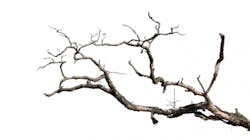No, You Cannot Have It All: The Beleaguered United Illuminating Co.
Fanciful thinking seems to play a large part in the public’s approach to utility vegetation management. There seems to be a perception that utility foresters know nothing about trees and indiscriminately cut them down because they are too ignorant to recognize the alternatives. Obviously these foresters are backed by utilities with an endless stream of money, which they are so eager to spend that they throw it into entirely unneeded activities.
OK, let me tell you what has stimulated my sarcasm. They (as in politicians and the public) are at it again in Connecticut berating beleaguered United Illuminating about their VM activities. A ‘spokeswoman for the Garden Club of New Haven said PURA needs to encourage UI to share all of the information it uses in determining that a tree has to be cut down entirely rather than trimmed (Luther Turmelle, New Haven Register, Apr. 8, 2015). Never mind that PURA changed the rules last year (see Quaking Resolve) such that the utilities need permission for tree work on private property and the approval of the Tree Warden for all pruning and removals on municipal property which from my reading of events has set the program back by a year. UI indicates they are following the rules. This isn’t good enough for Ms. Hirschoff the Garden Club spokeswoman because some Tree Wardens may not be proactive in challenging UI’s determinations. Of course nothing is said of the possibility that two arborists looking at the same tree might be in agreement about the risk posed by the tree. No, it is assumed that should the Tree Warden challenge the determination, the utility would be proven wrong.
Here is a statement from another resident on seeing 30 trees he believes to be marked for removal. “There are a few in their twilight years that I can understand UI removing but the rest are creatures of stately beauty and health. Wouldn’t it make more sense and save money to leave these trees alive, to trim rather than to clear-cut, to make educated decisions about what limbs and trees absolutely ‘need’ to be felled.”
Here is a statement from the New Haven Urban Resource Initiative (URI). “URI strongly believes that all healthy trees should be retained. Hazardous trees defined by the UI plan include those that are dead, have extensive decay, or are structurally weak. Since many structurally weak trees are healthy, we believe these trees require careful review by the Tree Warden to determine whether removal is warranted or whether pruning to remove weight loads is necessary to reduce risk to electric utility infrastructure.”
It’s demoralizing to have your integrity, intelligence and professional qualifications questioned. Just as the men and women working on storm restoration, usually in terrible conditions, are heroes, I think utility foresters are heroic for rallying their energies after such demoralizing blows and getting back on the horse by going out the next day to do their best to ensure safe, reliable electric service.
Now here is something from Rochester, Michigan. DTE has identified a 100 year old white pine on city property as the cause of repeated power outages. DTE has determined that trimming would leave the tree in an unhealthy condition. This of course would make the tree a public hazard and consequently, DTE has determined the only option is removal. A woman who’s property is adjacent has hired an arborist to evaluate the tree, hoping to have it designated a historic tree and hired a lawyer to obtain an injunction.
Back in 1970s the women’s movement came up with the expression of “having it all.” When I first heard this, it was about women having choices. Want to be a power lineman? Why not, if you’re capable of doing the work involved. Want to be doctor, a lawyer, a corporate executive. Again, why not? Obtain the qualifications. Somehow though, along the way “having it all” morphed into the realm of unicorns, magic dragons and pixie dust. The new interpretation goes roughly like this - you should be able to be a corporate executive pulling down a seven-figure income for no more than 35 hours a week so that you can dedicate quality time to your family and volunteer in your community. By now we’ve had a couple of generations brought up with this fanciful thinking. Somehow just believing you can have it all is supposed to expunge the fact that life is about choices. Choose to work no more than 35 hours a week then it is highly unlikely that you will be a corporate executive pulling down seven figures.
The unvarnished truth relating to trees and electric reliability is you cannot have it all. The frequency of tree-caused power outages is directly related to the amount of the tree exposure the electric system has. The greater the number of trees capable of falling into electric facilities, the lower the distance between trees and these facilities the higher the incidence of tree-caused service interruptions will be. While there is ongoing evidence of this, it is never more apparent than during storm loading. There is nothing (not even pixie dust) that will change neither this fact nor the facts that undergrounding will not save all the trees; is extremely expensive and if it is to be done, the ratepayers must pay for it.
As these cited public interventions have shown, utility arboricultural knowledge is not given high regard. Maybe we should use this to transfer the ownership of risk to outside parties. Maybe we should invite second and third opinions regarding tree removals, pruning and generally, what clearance should be provided. Of course, you will want the legal department to develop a form letter whereby the outside arborist’s signature guarantees that the specified tree will not fail and interrupt service or cause damage to the facilities. How much divergence of opinion from utility proposed VM actions would we find then?


